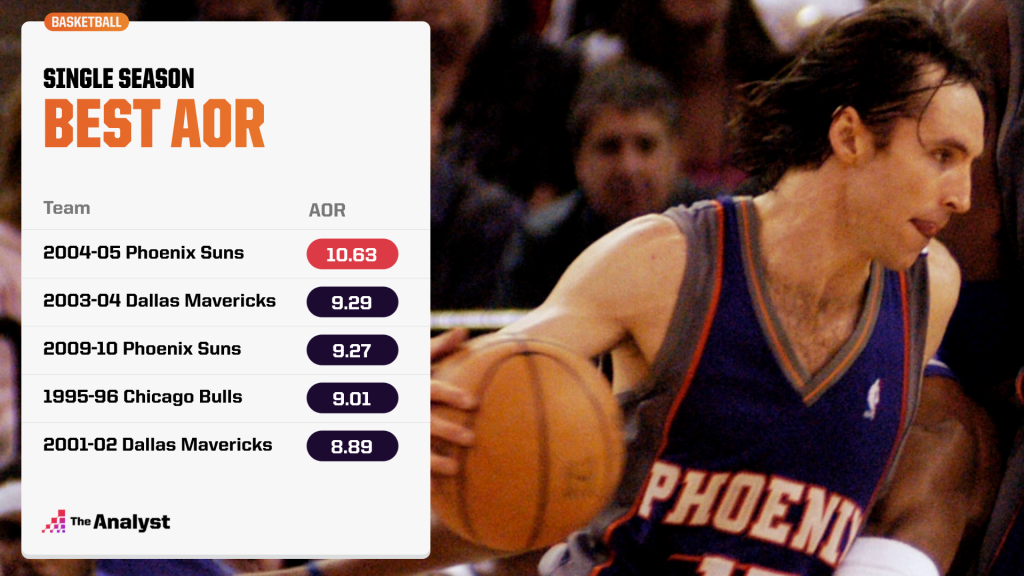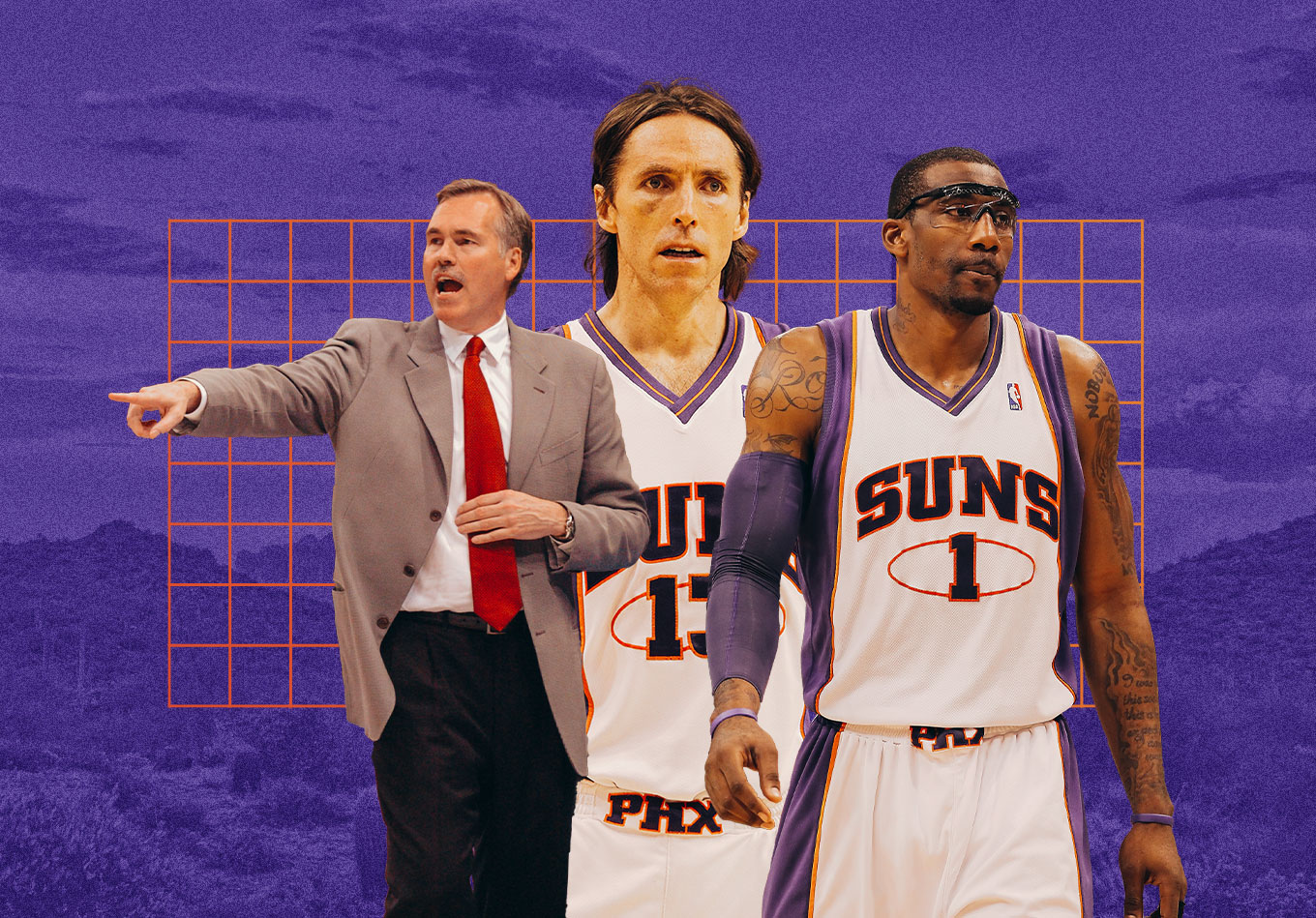It’s a simple question. Who is the greatest pick and roll tandem of all time? Many would say it was the tandem of John Stockton and Karl Malone – a pair of Hall of Famers who, under the guidance of the late great Jerry Sloan, burned defenses for nearly two decades.
However, the gold standard of this play type was actually birthed in the mid-2000s, when a series of fortunate circumstances led to the coalition of the likes of Steve Nash, Amar’e Stoudemire, and offensive mastermind Mike D’Antoni.
What makes this the case? How did these two teams’ styles differ? And what do our unique metrics have to say about these two offenses standing in NBA history?
Let’s find out.
Comparing the Characters
To be fully maximized, the pick and roll requires a great deal of freedom and creativity. Sloan, while a basketball genius in his own right, was all about consistency, regimentation, and execution.
During his time in Phoenix, D’Antoni took a hands off approach, allowing his players the opportunity for self-discovery and experimentation.
“We always had a section in our practice [where] we would just let them freelance. We had spots where people had to be, and from there, they could do whatever they wanted to do, whatever they thought,” D’Antoni told me during the Blazing the Trail podcast. “It was almost like a jam session.”
His philosophy was shaped by an amalgamation of experiences from his playing career. As an amateur baller at the University of Marshall, he got his first glimpse of the small-ball configurations that would guide his future lineup decisions.
“At Marshall, the center was a 6’5 guy, and the power forward…was out by the 3-point line.” D’Antoni said. The statement alludes to his inspiration for playing Stoudemire at center and having Shawn Marion, his power forward, hoist roughly four 3-point attempts per game from 2003-08.
During a brief stint with the San Antonio Spurs, he absorbed some meaningful tidbits from legendary ABA/NBA Coach Doug Moe about playing with pace. “I played for Doug Moe for about a month or two and learned about how fast he went,” D’Antoni said.
For reference, Doug Moe coached teams finished top-4 in the league in pace every year from 1976-90, finishing first twelve times during that span.
At point guard, Stockton was a force to reckoned with as a shooter and passer, but he was a hesitant driver who rarely ventured into the paint (a phenomenon best described by this clip here).
When this character flaw manifests itself in your primary ballhandler, it places a massive constraint on your offense because you can’t collapse the defense and unlock the higher-value passes that lead to layups and open 3-pointers.
A modern-day example of this deficiency can be seen with Dejounte Murray. His box score stats look great (21.1/8.3/9.2), but his inability as a primary ballhandler to get two feet in the paint greatly inhibited the Spurs’ offense this past season (tied for 17th in the league).
On the flip side, Nash reached sage levels in the art of maneuvering his way toward the basket and, from there, dancing in the paint. And when you combine this with his other gifts – shooting, finishing, and on-ball decision-making/creation – you have an extremely deadly offensive initiator. As D’Antoni explains:
“Steve was one of the best all-time shooters ever – from threes, from midrange, and foul shots. A good finisher, maybe not a great finisher because of his physique, but a good one. [He] could create. And probably the best of all … was his decision-making.”
D’Antoni continued, “Steve was the best I’ve ever seen at making the right decision at the right time.”
The Stoudemire/Malone comparison is where things get a bit dicey. In totality, Malone clearly had the better playing career. However, while we remember him as one half of a conjoined force, he was more of a tag team partner, being summoned into action by his counterpart only to then operate as a solo act.
Malone was more of an isolationist than a play-finisher. He thrived in post-up scenarios on the low block, where he could leverage his gargantuan strength and thoughtful passing skills to whittle away at his adversary. Unfortunately, Malone’s robust frame took away from his verticality, which, in turn, made him a poor finisher in the halfcourt (a key component to the pick and roll).
Stoudemire, on the other hand, functioned more like Shawn Kemp. And like “The Reign Man,” Stoudemire had all the physical attributes necessary to flourish as a roller.
“Amar’e was great at finding a way to cut and get the ball,” D’Antoni said. “[He] was so fast and so quick that [if] a guy took his eyes off him for one second, he’d be up for the lob or backdoor [immediately].”
The difference in their styles is illustrated when you look at the frequency of shots between 0-3 feet and dunks they have attempted for their careers (shot attempts that are commonly associated with high-volume play-finishing). Please remember that this data only stretches back until 1996, so it only encompasses the back nine of Malone’s career.
| Player Name | % of FGA from 0-3 Feet | % of FGA from Dunks |
|---|---|---|
| Karl Malone | 32.1% | 2.7% |
| Amar’e Stoudemire | 44.8% | 15.9% |
Differing Styles
“You’re talking about polar opposites,” former All-League defender Raja Bell said of Jerry Sloan and Mike D’Antoni on the Blazing the Trail podcast.
A major misconception about that iteration of Jazz basketball is that they were primarily a pick-and-roll oriented offense. However, for the reasons we mentioned above, Stockton and Malone’s skills weren’t suited for high-volume pick and roll, so Sloan focused on a sequential offense predicated on off-ball cutting and screening. Staples like UCLA and flex cuts, split actions, and post-ups made up the lion’s share of their offensive possessions.
And when they did execute on-ball screens, instead of stampeding into the paint, Malone would pop out for a midrange jumper.
A common misnomer about those mid-2000s Suns’ teams was that their legacy was forged entirely on transition escapades. This couldn’t be further from the truth. In fact, the fastest pace recorded during the Nash epoch (96.7 in 2008) would only be good for 24th in the league in 2022.
More than anything, Phoenix was a halfcourt-centric team renowned for popularizing a variation of the pick and roll known today as the “spread pick and roll.”
“A lot of what we did was predicated on pace, but you can’t play an entire game up and down like that,” Bell said. “The culmination of a lot of our things, if you couldn’t find a basket prior to that, would be a pick and roll.”
Here’s a visual example of the spread pick and roll in practice (volume up):
At its core, the play’s ingredients consisted of a simple ballscreen with three shooters spaced out on the perimeter – two in the corners and one in the slot.
The hallmark feature of the playtype was optionality. If the defense gave Nash some room, he could burn them from the perimeter, midrange, or at the rim. If they neglect Stoudamire, he’d dunk all over them. If one of the other three defenders tried to offer some complementary resistance on the backside, Nash could spray the ball over to the newly open shooter at a moment’s notice. In total, this formation gave the Suns five different options (Nash, Stoudamire, and the three shooters) to choose from every single time.
What made Phoenix uniquely tailored for this arrangement is that, like Stephen Curry today, Nash could counter every type of pick and roll coverage. Against drop coverage, he could burn you with his lethal pullup jumper. Hedge or trap him, and Nash could pinpoint the opening created in an instant. And if you switched, he would request a slow song and dance with his lethargic partner all the way to an easy score.
“I played Steve [in 2002]. This was with the 76ers. We were going into Dallas,” Raja recalled. “And he just destroyed me.”
What the Numbers Say
Cross-era comparisons are made difficult by the various changes that occur from decade to decade. A statistic like raw Offensive Rating (number of points scored per 100 possessions) doesn’t add much context in exercises like this because of the massive spike in league-wide offensive efficiency.
Fortunately, we have an unbiased model that offers direction when making these comparisons.
The model uses data on both sides of the ball to calculate how many points per 100 possessions better or worse championship teams from 1986-87 to 2021-22 were than the average team during those specific seasons, including the playoffs. The output it produces is that team’s Adjusted Team Rating (ATR).
And for specific comparison, we also have Adjusted Team Offensive Ratings. Here is a look at Utah and Phoenix Adjusted Team Offensive Ratings (AOR) during their best six-year runs:
| Year | UTA AOR (League Rank) | Year | PHX AOR (League Rank) |
|---|---|---|---|
| 95-96 | 6.77 (2nd) | 04-05 | 10.63 (1st) |
| 96-97 | 7.01 (2nd) | 05-06 | 6.60 (1st) |
| 97-98 | 5.13 (4th) | 06-07 | 7.79 (1st) |
| 98-99 | 2.20 (8th) | 07-08 | 7.00 (2nd) |
| 99-00 | 3.26 (7th) | 08-09 | 6.18 (2nd) |
| 00-01 | 4.91 (4th) | 09-10 | 9.27 (1st) |
The Jazz had high-level offenses throughout their reign of dominance in the late 1990s/early 2000s, which makes sense because Stockton and Malone are all-time caliber talents. But they ultimately fell short of the splendor the Suns attained partially because of the pick-and-roll deficiencies we highlighted above. There’s a reason it has grown so prominent in today’s game. The best pick and roll offenses are typically the best overall offenses.
Even more impressive for Phoenix, the 2004-05 group that produced a score of 10.63 is the greatest offense ever recorded in our database, while the 2009-10 offense ranks third all-time – narrowly defeated by the 2003-04 Dallas Mavericks (that coincidentally also featured Steve Nash).

A truly magnificent offensive dynasty indeed.
Graphic design by Matt Sisneros
